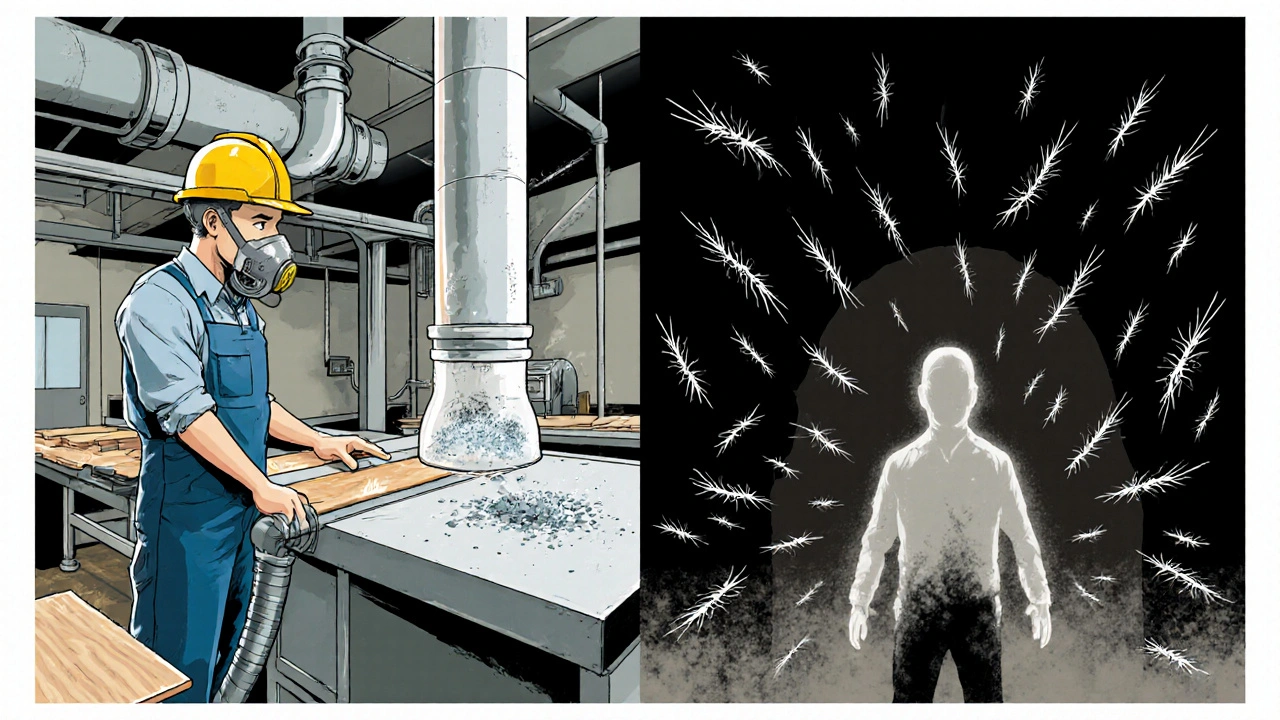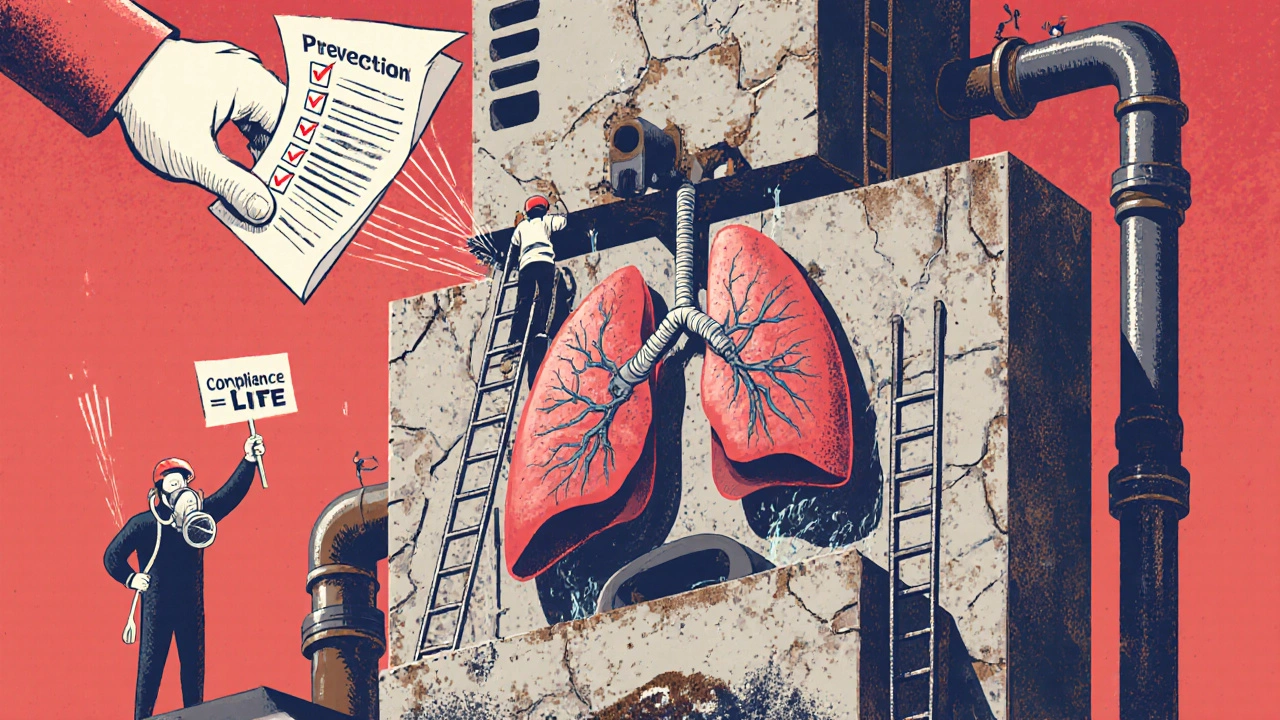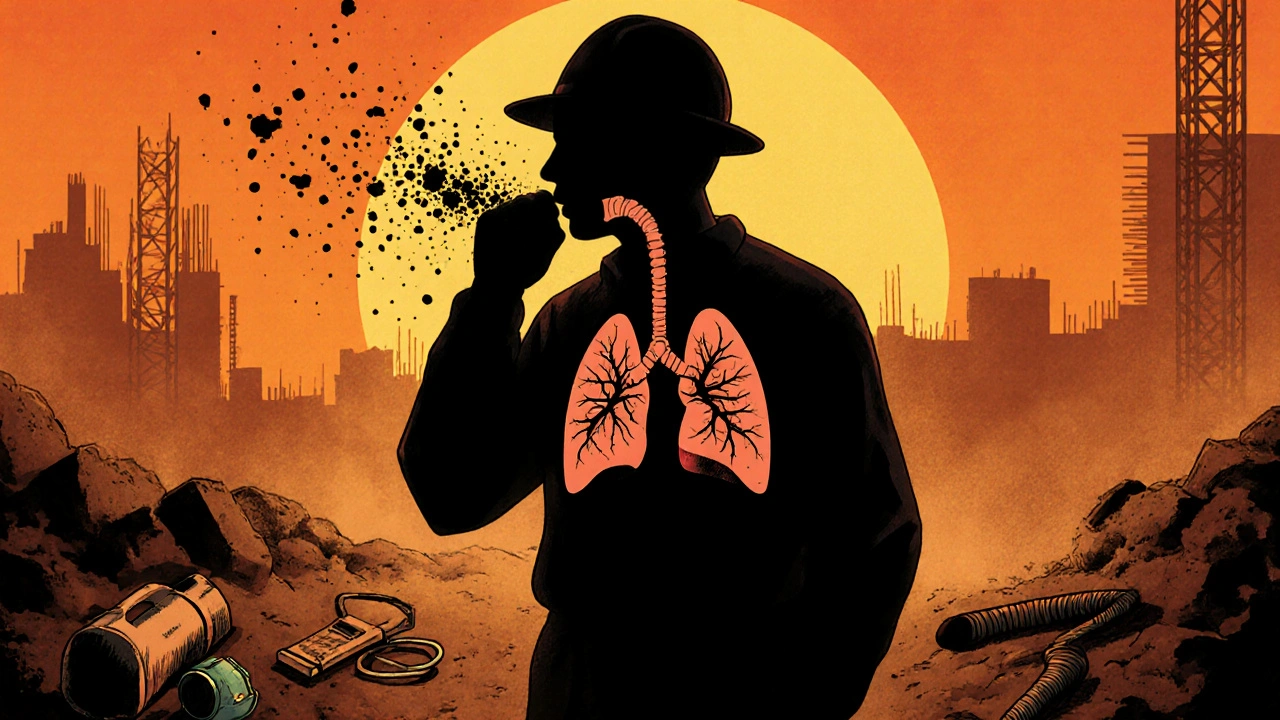Every year, over 2,000 workers in the U.S. die from lung diseases caused by breathing in dust and fibers they were never supposed to inhale. These aren’t random accidents. They’re preventable. Silicosis and asbestosis are two of the most common-and deadliest-occupational lung diseases still happening today, even though we’ve known how to stop them for decades.
What Silicosis Does to Your Lungs
Silicosis starts with something as simple as cutting stone, grinding concrete, or sandblasting metal. When you do these tasks without protection, you breathe in tiny particles of crystalline silica. These particles don’t just pass through your lungs. They get stuck, and your body tries to fight them off. Over time, the constant battle turns healthy lung tissue into hard, scarred tissue. Your lungs lose their elasticity. Breathing becomes harder. You start coughing. Then you get winded climbing stairs. Eventually, you can’t breathe without help.
This isn’t new. Ancient Egyptian stone workers showed signs of silicosis over 3,000 years ago. In 1870, an Italian doctor named Achille Visconti linked it to miners. Today, it’s still killing people-about 1,200 U.S. workers every year, according to NIOSH data. And it’s not just miners. Construction workers, tile installers, foundry workers, and even those doing home renovations are at risk. Dry cutting a countertop? That’s enough to release dangerous levels of silica dust.
Asbestosis: The Silent Scarring Disease
Asbestosis is similar, but it comes from asbestos fibers. These are microscopic, needle-like threads that lodge deep in the lungs. Unlike silica, asbestos doesn’t dissolve. It stays there for life, slowly causing inflammation and scarring. Symptoms show up 10 to 40 years after exposure. By then, the damage is irreversible.
It was first identified in 1906 after an autopsy of a 33-year-old factory worker in London. Back then, asbestos was called “magic mineral” for its fireproofing and insulating properties. It was in insulation, roofing, pipe wrap, floor tiles, even school buildings. The U.S. Environmental Protection Agency estimates 733,000 public buildings still contain asbestos. That means teachers, maintenance staff, and renovation crews are still at risk.
Between 2004 and 2014, 1,163 U.S. workers died from asbestosis. And unlike silicosis, there’s no safe level of asbestos exposure. The International Agency for Research on Cancer says asbestos is a known human carcinogen. Even one fiber can matter. That’s why it’s not just about reducing exposure-it’s about eliminating it.
Why Prevention Works-And Why It Often Fails
The good news? Neither silicosis nor asbestosis has to happen. The bad news? Too many workplaces still treat safety as an afterthought.
OSHA and NIOSH have clear guidelines. The hierarchy of controls says the best way to protect workers is to eliminate the hazard first. That means replacing materials when possible-like using non-silica abrasives instead of sandblasting. Next comes engineering controls: local exhaust ventilation, wet cutting methods, and enclosed systems.
Wet cutting reduces silica dust by up to 90%. Local exhaust ventilation on power tools cuts exposure by 70-80%. These aren’t theoretical. They’re proven. OSHA’s 2021 enforcement data showed companies using wet methods had dramatically lower dust levels.
But here’s the problem: many employers skip these steps. They rely on masks. And not just any mask. N-95 respirators filter 95% of particles 0.3 microns in size. P-100s filter 99.97%. But if the mask doesn’t fit, it’s useless. A CDC report found 68% of worker complaints about respirators were about discomfort or poor fit. Workers in 90-degree heat remove them. Others cut holes in them. One Reddit user wrote: “I’ve been in demolition 15 years-never had a proper fit test until OSHA showed up.”
Engineering controls reduce exposure by 80-90%. Administrative controls (like rotating workers) drop it by 50-70%. PPE alone? Only 40-60%-and only if used perfectly every single time. That’s why OSHA says PPE is the last line of defense, not the first.

What Real Prevention Looks Like
True prevention isn’t just buying masks. It’s a system.
- Engineering controls: Install local exhaust ventilation on every saw, grinder, or drill that creates dust. Keep air velocity at 100-150 feet per minute at the source. Seal cutting operations to capture 95% of dust.
- Wet methods: Always use water when cutting stone, tile, or concrete. No dry cutting.
- Respirators: Use P-100s for silica and asbestos. Get fit-tested annually. Store them clean and dry. No modifications.
- Training: OSHA requires 2 hours of training. The American Lung Association recommends 4-6 hours, with annual refreshers. Workers need to understand why it matters-not just what to do.
- Health monitoring: Baseline spirometry tests, then every 5 years. Annually if you have asthma, COPD, or have already been exposed. Early detection can slow disease progression by 30-50%.
And here’s something no one talks about enough: smoking. If you’re exposed to silica or asbestos and you smoke, your risk of lung disease goes up by 50-70%. A tobacco-free workplace isn’t just a policy-it’s a lifesaver.
The Human Side: Culture and Compliance
Technology exists. Regulations exist. So why do these diseases still happen?
Because culture matters more than compliance.
A 2023 report from the Work-Fit blog looked at 15 construction companies that cut respiratory incidents by 65% over three years. What did they do differently? Supervisors wore their respirators every single day. No exceptions. Workers saw it. They followed. When foremen yelled at workers for taking too long with wet saws, those companies fired them.
Small businesses struggle the most. Wisconsin data from 2021 showed 78% of companies with fewer than 20 employees had no formal respiratory protection program. They don’t have safety officers. They don’t have budgets. But the cost of one silicosis case-medical bills, lost work, disability-can be $500,000 or more. A $5,000 ventilation system pays for itself in 18-24 months.
OSHA fined construction companies $3.2 million in 2021 for silica violations. That’s not punishment. That’s a warning. The real penalty is a worker who can’t breathe.

What’s Changing Now
There’s progress. NIOSH launched the “Prevent eTool” in 2023-a free digital guide for 15 high-risk industries. Companies using it saw a 40% drop in respiratory incidents in just six months.
OSHA’s National Emphasis Program on silica has conducted over 1,200 inspections since late 2022. They’re not just writing tickets-they’re forcing change.
In Europe, countries like Germany are seeing 55% fewer new cases thanks to mandatory health checks and exposure monitoring. The European Respiratory Society wants to eliminate all occupational lung diseases by 2030.
And new tools are coming. Wearable sensors now give real-time dust readings. Workers get alerts when levels rise. It’s like a smoke alarm for your lungs.
You’re Not Just a Worker. You’re a Person.
If you work in construction, demolition, mining, or manufacturing, you’ve probably been told, “Just wear your mask.” But masks aren’t enough. If your company doesn’t have wet cutting, ventilation, or fit testing, you’re being set up to fail.
Speak up. Ask for training. Demand a proper respirator fit test. Report unsafe conditions. OSHA’s whistleblower protections are real. You can’t be fired for asking for safety.
If you’re a supervisor or business owner: don’t wait for OSHA to show up. Install the ventilation. Buy the wet saws. Train your team. Make safety part of your daily routine-not a checkbox.
Silicosis and asbestosis are not inevitable. They are the result of choices. Choices made by companies, managers, and sometimes workers themselves. But the good news? We have the tools to stop them. Now we just need to use them.
Can you get silicosis from one-time exposure to silica dust?
While silicosis usually develops after years of exposure, acute silicosis can occur after just a few weeks or months of very high exposure-like sandblasting without protection. This form is rare but deadly. Even short-term exposure to high levels of silica can cause lung damage. There’s no safe threshold for silica dust.
Is asbestosis the same as mesothelioma?
No. Asbestosis is scarring of lung tissue caused by asbestos fibers. It’s not cancer, but it makes breathing difficult. Mesothelioma is a rare and aggressive cancer of the lining of the lungs, heart, or abdomen. Both are caused by asbestos, but they’re different diseases. Mesothelioma has no cure. Asbestosis can be managed but not reversed.
Are N-95 masks enough for silica or asbestos?
N-95 masks filter 95% of particles, but they’re not designed for asbestos or high levels of silica. P-100 respirators are recommended because they filter 99.97% of particles, including oil-based ones. OSHA requires P-100s for asbestos work and strongly recommends them for silica tasks with high exposure. N-95s are only acceptable for low-risk, occasional exposure.
How often should workers get lung function tests?
Workers exposed to silica or asbestos should get a baseline spirometry test before starting the job. After that, testing should happen at least every five years. If you already have lung issues, smoke, or have had high exposure, annual testing is recommended. Early detection can slow disease progression by 30-50%.
Can you still get sick from asbestos if it’s not disturbed?
No. Asbestos only becomes dangerous when it’s damaged or disturbed-like during renovation, drilling, or demolition. Intact asbestos in walls or pipes doesn’t release fibers. But if you’re working near it, even slightly, you risk exposure. That’s why trained professionals with proper equipment must handle any asbestos removal.
What should I do if my employer won’t provide proper safety equipment?
Document everything-dates, tasks, lack of equipment, any symptoms. Then file a complaint with OSHA. You have the legal right to a safe workplace. OSHA protects whistleblowers. You can report anonymously. Don’t wait until you’re sick. Prevention starts with speaking up.
